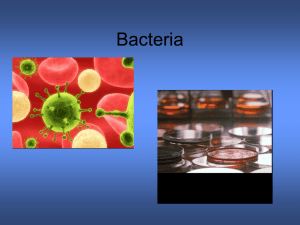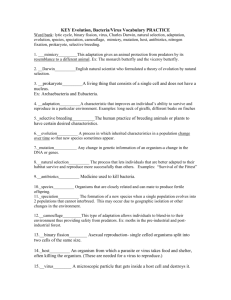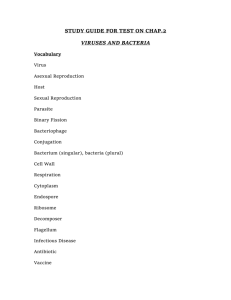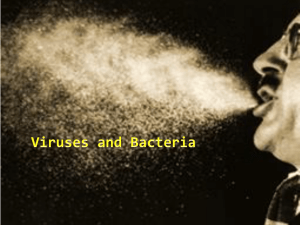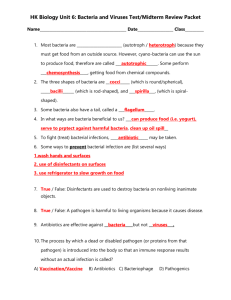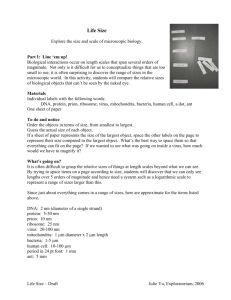EOC Review: Cells & Viruses Cells: Smallest Unit of Life in all living
advertisement
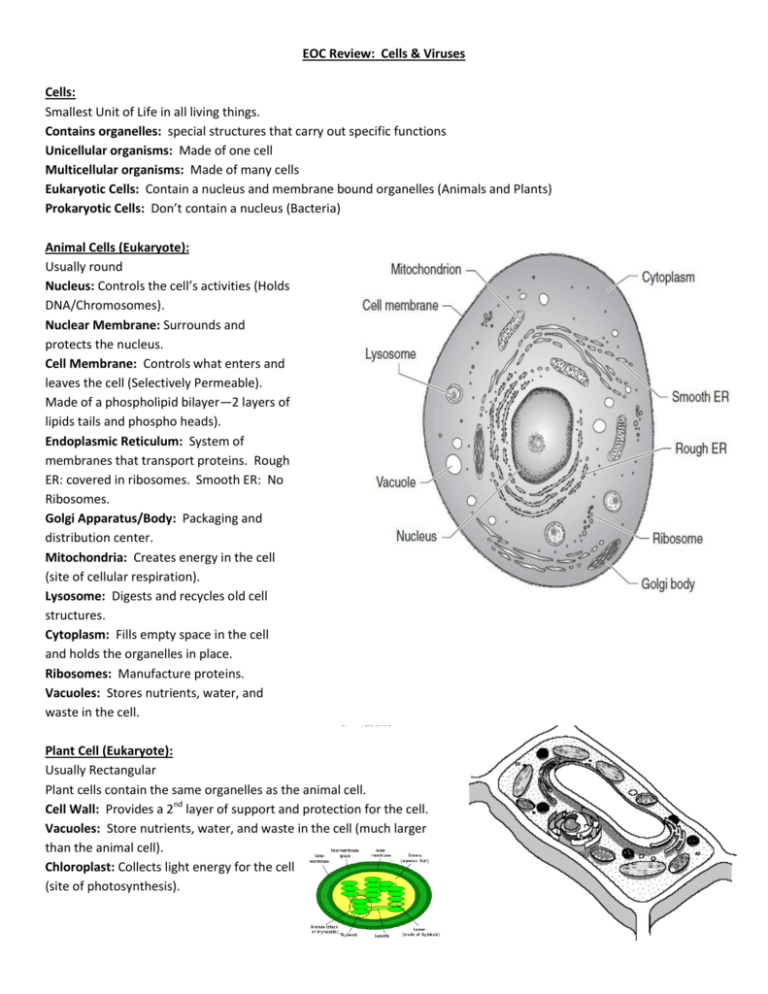
EOC Review: Cells & Viruses Cells: Smallest Unit of Life in all living things. Contains organelles: special structures that carry out specific functions Unicellular organisms: Made of one cell Multicellular organisms: Made of many cells Eukaryotic Cells: Contain a nucleus and membrane bound organelles (Animals and Plants) Prokaryotic Cells: Don’t contain a nucleus (Bacteria) Animal Cells (Eukaryote): Usually round Nucleus: Controls the cell’s activities (Holds DNA/Chromosomes). Nuclear Membrane: Surrounds and protects the nucleus. Cell Membrane: Controls what enters and leaves the cell (Selectively Permeable). Made of a phospholipid bilayer—2 layers of lipids tails and phospho heads). Endoplasmic Reticulum: System of membranes that transport proteins. Rough ER: covered in ribosomes. Smooth ER: No Ribosomes. Golgi Apparatus/Body: Packaging and distribution center. Mitochondria: Creates energy in the cell (site of cellular respiration). Lysosome: Digests and recycles old cell structures. Cytoplasm: Fills empty space in the cell and holds the organelles in place. Ribosomes: Manufacture proteins. Vacuoles: Stores nutrients, water, and waste in the cell. Plant Cell (Eukaryote): Usually Rectangular Plant cells contain the same organelles as the animal cell. Cell Wall: Provides a 2nd layer of support and protection for the cell. Vacuoles: Store nutrients, water, and waste in the cell (much larger than the animal cell). Chloroplast: Collects light energy for the cell (site of photosynthesis). Bacteria Cells (Prokaryote): Smallest and simplest cells. Unicellular No Nucleus Contain DNA, Cell Wall, Cytoplasm, and Ribosomes. Capsule: Provides a 3rd layer of protection and support for Bacteria. Flagella: whip like tail for mobility (also found in the gametes of some plant and animal cells). Pili: Tiny hairs that allow bacteria to adhere to substances. Binary Fission: Simple cellular reproduction in which the bacteria cell and its DNA divide in half, creating two identical bacteria cells. Pathogens: Disease causing agents. Some bacteria cause diseases such as cholera, dental cavities, and tuberculosis. 99% of Bacteria are not pathogenic. Escherichia Coli: a bacterium that lives in the intestines of animals aids in digestion. Some bacteria are used to make foods such as yogurt, cheese, and bread. Bacterial infections are treated with antibiotics. Bacteria come in 3 primary shapes: Coccus (round), Bacillus (rod), Spirillum (spiral). and Viruses: Non-cellular (Not Cells) Non-living Contain DNA or RNA (genetic material) Cannot Metabolize (create own energy) Cannot Reproduce without a host cell (must inject DNA or RNA into host cell). Lysogenic Cycle: Virus enters the host cell and waits for the host cell to reproduce. All of the newly formed cells will contain the virus. Lytic Cycle: Virus enters the host cell and allows the host cell to repeatedly replicate the virus until the cell bursts. The host cell is destroyed and the newly formed viruses spread rapidly. All viruses are pathogenic (disease causing). Vaccines: Weakened forms of a virus used to prevent future infections. Vaccines stimulate the immune system by allowing the immune system to recognize and destroy the virus. HIV (Human Immunodeficiency Virus): The virus destroys T-Cells and blocks the body’s immune response, signaling the onset of AIDS. This process often takes years to occur after initial infection. HIV is transmitted by sexual contact, shared needles, mother to baby at birth, and breast milk. Influenza (flu): Virus spreads when an infected person coughs or sneezes. Symptoms are more severe than a cold. Retrovirus: a RNA virus. These viruses incorporate their RNA into the hosts DNA. As a result, the host mistakenly reproduces the viral DNA (Influenza and HIV are retroviruses).
